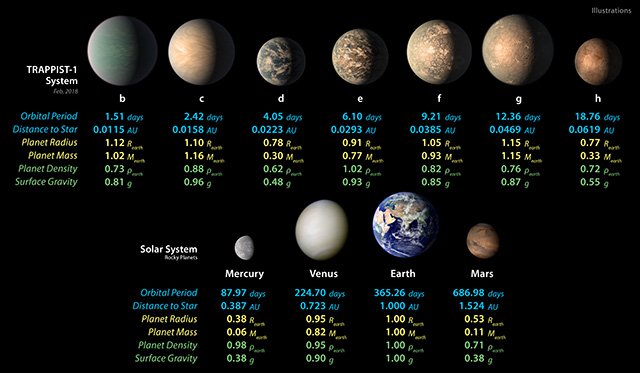
April 13, 2023
Feature Story
What Webb is Learning About Exoplanet Atmospheres

This chart shows, on the top row, artist concepts of the seven planets of TRAPPIST-1 with their orbital periods, distances from their star, radii, masses, densities and surface gravity as compared to those of Earth.Image credit: NASA/JPL-Caltech.
NASA’s James Webb Space Telescope began returning data in 2022 and, in just a short amount of time, the mission has revealed new information about the composition of exoplanets, the presence of atmospheres around such planets, and the makeup of some of these atmospheres.
Observations from Webb are already providing unexpected findings. For instance, the results indicate that the atmospheres of gas giant planets around distant stars don’t necessarily follow the same trends we see in our own Solar System. Webb has also provided new insight into the Trappist-1 system, a stellar system that hosts Earth-sized planets. For the first time, Webb was able to obtain a thermal signature from the planet nearest the system’s host star.
The study, “Thermal Emission from the Earth-sized Exoplanet TRAPPIST-1 b using JWST,” was published in the journal Nature.
TRAPPIST-1 is an ultra cool M-dwarf star, and it appears that these types of stars often host Earth-sized planets. Understanding the conditions present around TRAPPIST-1 and the worlds it hosts will help astrobiologists determine if such systems could support habitable planets.
Click here to read more about findings from Webb’s early release program of exoplanet results from Many Worlds.
The Many Worlds Blog chronicles the search for evidence of life beyond Earth written by author/journalist Marc Kaufman. The “Many Worlds” column is supported by the Lunar Planetary Institute/USRA and informed by NASA’s NExSS initiative, a research coordination network supported by the NASA Astrobiology Program. Any opinions expressed are the author’s alone.